雅思阅读模拟试题及答案解析(4)
雅思阅读预测真题库4参考答案
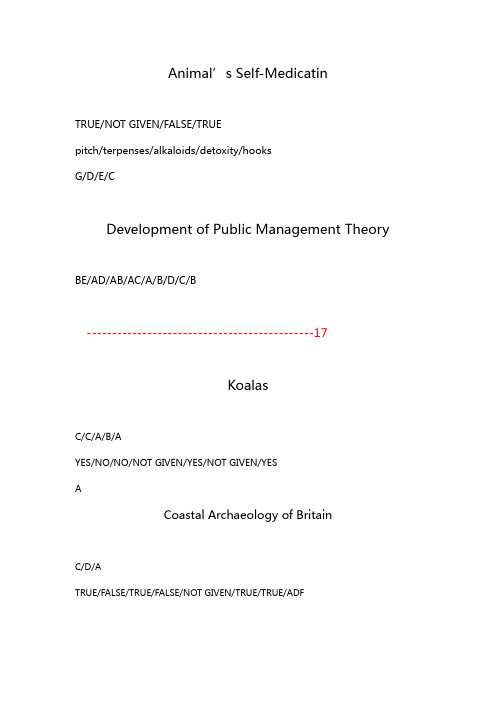
Animal’s Self-MedicatinTRUE/NOT GIVEN/FALSE/TRUEpitch/terpenses/alkaloids/detoxity/hooksG/D/E/CDevelopment of Public Management Theory BE/AD/AB/AC/A/B/D/C/B---------------------------------------------17KoalasC/C/A/B/AYES/NO/NO/NOT GIVEN/YES/NOT GIVEN/YESACoastal Archaeology of BritainC/D/ATRUE/FALSE/TRUE/FALSE/NOT GIVEN/TRUE/TRUE/ADFCommunication Styles and Conflictiii/vii/i/iv/ix/viii/v/iiTRUE/FALSE/NOT GIVEN/TRUE/TRUEBTalc Powder Applied on Food and Agricultural Industries B/B/A/A/C/B20/foam/wastewater/harmful/biodegrade/droplet(s)/lamination(packing)/gr ape grower(s)Human Navigation-finding our wayB /C / A / C / B / C /D / A /TRUE / NOT GIVEN / TRUE / FALSE / NOT GIVENPlant ScentsB/A/F/CTRUE/NOT GIVEN/TRUE/FALSEB/B/C/D/AAgriculture and T ourismA/B/C/C/A/B/Dbenefit/survey/three/cooperation/experience/incomesE-trainingiii/v/vii/ii/ix/viiiD/B/A/F/ACDChoices and HappinessB/D/A/CFALSE/NOT GIVEN/TRUE/FALSE/TRUEB/A/D/CPaper or Computer ?iv / iii /viii /ii / ix /vii / iflexible /tangible / tailorableC /A / A /DThe “Extinct”Grass in BritainFALSE/FALSE/NOT GIVEN/TRUE/FALSE/TRUE/NOT GIVENE/F/A/D/B/CExtinction Mysterious of the DinosaursNO/YES/NOT GIVEN/YES/NO/YESecologicalrelease/competitors/dragons/overlooked/vanished/recycled/ misdatedMalaria in Italyinsect/unclean air/life expectancy/hereditaryYES/NG/NO/YESE/G/B/F/C/AAntarctica--in from the ColdD/E/F/C/A/C/A/B/B/D/C/A/CThe PearlB/D/E/ETRUE/FALSE/NOT GIVENB/J/K/F/C/DThe History of “Farmer”E/B/G/D/Hmail-order company/chain store/buying offices/celebration/big family/B/C/ABiodiversityTRUE/FALSE/TRUE/TRUE/FALSE/NOT GIVEN/NOT GIVEN keystone(species)/fig families(or figs)/(sea) urchins/cactus moth/Australia/public educationFood for Thoughtviii/ii/iv/x/i/v/viiH/F/I/A/C/B/E。
雅思阅读考试模拟试练习题及答案解析新
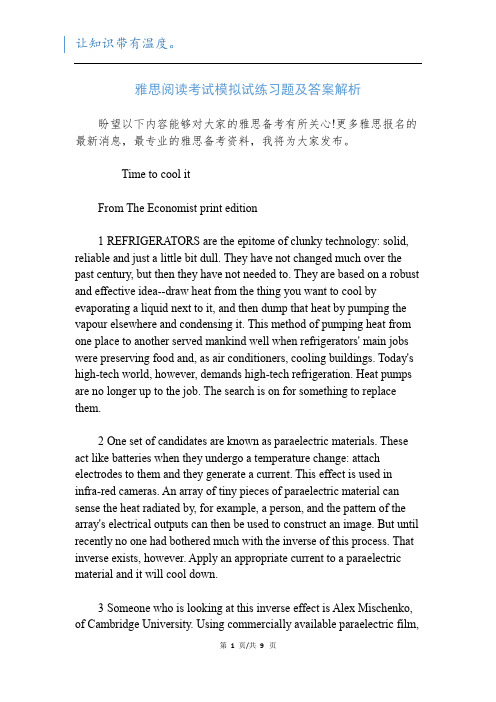
雅思阅读考试模拟试练习题及答案解析盼望以下内容能够对大家的雅思备考有所关心!更多雅思报名的最新消息,最专业的雅思备考资料,我将为大家发布。
Time to cool itFrom The Economist print edition1 REFRIGERATORS are the epitome of clunky technology: solid, reliable and just a little bit dull. They have not changed much over the past century, but then they have not needed to. They are based on a robust and effective idea--draw heat from the thing you want to cool by evaporating a liquid next to it, and then dump that heat by pumping the vapour elsewhere and condensing it. This method of pumping heat from one place to another served mankind well when refrigerators' main jobs were preserving food and, as air conditioners, cooling buildings. Today's high-tech world, however, demands high-tech refrigeration. Heat pumps are no longer up to the job. The search is on for something to replace them.2 One set of candidates are known as paraelectric materials. These act like batteries when they undergo a temperature change: attach electrodes to them and they generate a current. This effect is used in infra-red cameras. An array of tiny pieces of paraelectric material can sense the heat radiated by, for example, a person, and the pattern of the array's electrical outputs can then be used to construct an image. But until recently no one had bothered much with the inverse of this process. That inverse exists, however. Apply an appropriate current to a paraelectric material and it will cool down.3 Someone who is looking at this inverse effect is Alex Mischenko, of Cambridge University. Using commercially available paraelectric film,he and his colleagues have generated temperature drops five times bigger than any previously recorded. That may be enough to change the phenomenon from a laboratory curiosity to something with commercial applications.4 As to what those applications might be, Dr Mischenko is still a little hazy. He has, nevertheless, set up a company to pursue them. He foresees putting his discovery to use in more efficient domestic fridges and air conditioners. The real money, though, may be in cooling computers.5 Gadgets containing microprocessors have been getting hotter for a long time. One consequence of Moore's Law, which describes the doubling of the number of transistors on a chip every 18 months, is that the amount of heat produced doubles as well. In fact, it more than doubles, because besides increasing in number, the components are getting faster. Heat is released every time a logical operation is performed inside a microprocessor, so the faster the processor is, the more heat it generates. Doubling the frequency quadruples the heat output. And the frequency has doubled a lot. The first Pentium chips sold by Dr Moore's company, Intel, in 1993, ran at 60m cycles a second. The Pentium 4--the last "single-core" desktop processor--clocked up 3.2 billion cycles a second.6 Disposing of this heat is a big obstruction to further miniaturisation and higher speeds. The innards of a desktop computer commonly hit 80℃. At 85℃, they stop working. Tweaking the processor's heat sinks (copper or aluminium boxes designed to radiate heat away) has reached its limit. So has tweaking the fans that circulate air over those heat sinks. And the idea of shifting from single-core processors to systems that divided processing power between first two, and then four, subunits, in order to spread the thermal load, also seems to have the endof the road in sight.7 One way out of this may be a second curious physicalphenomenon, the thermoelectric effect. Like paraelectric materials, this generates electricity from a heat source and produces cooling from an electrical source. Unlike paraelectrics, a significant body of researchers is already working on it.8 The trick to a good thermoelectric material is a crystal structure in which electrons can flow freely, but the path of phonons--heat-carrying vibrations that are larger than electrons--is constantly interrupted. In practice, this trick is hard to pull off, and thermoelectric materials are thus less efficient than paraelectric ones (or, at least, than those examined by Dr Mischenko). Nevertheless, Rama Venkatasubramanian, of Nextreme Thermal Solutions in North Carolina, claims to have made thermoelectric refrigerators that can sit on the back of computer chips and cool hotspots by 10℃. Ali Shakouri, of the University of California, Santa Cruz, says his are even smaller--so small that they can go inside the chip.9 The last word in computer cooling, though, may go to a system even less techy than a heat pump--a miniature version of a car radiator. Last year Apple launched a personal computer that is cooled by liquid that is pumped through little channels in the processor, and thence to a radiator, where it gives up its heat to the atmosphere. To improve on this, IBM's research laboratory in Zurich is experimenting with tiny jets that stir the liquid up and thus make sure all of it eventually touches the outside of the channel--the part where the heat exchange takes place. In the future, therefore, a combination of microchannels and either thermoelectrics or paraelectrics might cool computers. The old, as it were, hand in hand with the new.(830 words)Questions 1-5Complete each of the following statements with the scientist or company name from the box below.Write the appropriate letters A-F in boxes 1-5 on your answer sheet.A. AppleB. IBMC. IntelD. Alex MischenkoE. Ali ShakouriF. Rama Venkatasubramanian1. ...and his research group use paraelectric film available from the market to produce cooling.2. ...sold microprocessors running at 60m cycles a second in 1993.3. ...says that he has made refrigerators which can cool the hotspots of computer chips by 10℃.4. ...claims to have made a refrigerator small enough to be built intoa computer chip.5. ...attempts to produce better cooling in personal computers by stirring up liquid with tiny jets to make sure maximum heat exchange.Questions 6-9Do the following statements agree with the information given in the reading passage?In boxes 6-9 on your answer sheet writeTRUE if the statement is true according to the passageFALSE if the statement is false according to the passageNOT GIVEN if the information is not given in the passage6. Paraelectric materials can generate a current when electrodes are attached to them.7. Dr. Mischenko has successfully applied his laboratory discovery to manufacturing more efficient referigerators.8. Doubling the frequency of logical operations inside a microprocessor doubles the heat output.9. IBM will achieve better computer cooling by combining microchannels with paraelectrics.Question 10Choose the appropriate letters A-D and write them in box 10 on your answer sheet.10. Which method of disposing heat in computers may have a bright prospect?A. Tweaking the processors?heat sinks.B. Tweaking the fans that circulate air over the processor抯heat sinks.C. Shifting from single-core processors to systems of subunits.D. None of the above.Questions 11-14Complete the notes below.Choose one suitable word from the Reading Passage above for each answer.Write your answers in boxes 11-14 on your answer sheet.Traditional refrigerators use...11...pumps to drop temperature. At present, scientists are searching for other methods to produce refrigeration, especially in computer microprocessors....12...materials have been tried to generate temperature drops five times bigger than any previously recorded. ...13...effect has also been adopted by many researchers to cool hotspots in computers. A miniature version of acar ...14... may also be a system to realize ideal computer cooling in the future.Key and Explanations:1. DSee Paragraph 3: ...Alex Mischenko, of Cambridge University. Using commercially available paraelectric film, he and his colleagues have generated temperature drops...2. CSee Paragraph 5: The first Pentium chips sold by Dr Moore's company, Intel, in 1993, ran at 60m cycles a second.3. FSee Paragraph 8: ...Rama Venkatasubramanian, of Nextreme Thermal Solutions in North Carolina, claims to have made thermoelectric refrigerators that can sit on the back of computer chips and cool hotspots by 10℃.4. ESee Paragraph 8: Ali Shakouri, of the University of California, Santa Cruz, says his are even smaller梥o small that they can go inside the chip.5. BSee Paragraph 9: To improve on this, IBM's research laboratory in Zurich is experimenting with tiny jets that stir the liquid up and thus make sure all of it eventually touches the outside of the channel--the part where the heat exchange takes place.6. TRUESee Paragraph 2: ...paraelectric materials. These act like batteries when they undergo a temperature change: attach electrodes to them and they generate a current.7. FALSESee Paragraph 3 (That may be enough to change the phenomenon from a laboratory curiosity to something with commercial applications. ) and Paragraph 4 (As to what those applications might be, Dr Mischenko is still a little hazy. He has, nevertheless, set up a company to pursue them. He foresees putting his discovery to use in more efficient domestic fridges?8. FALSESee Paragraph 5: Heat is released every time a logical operation is performed inside a microprocessor, so the faster the processor is, the more heat it generates. Doubling the frequency quadruples the heat output.9. NOT GIVENSee Paragraph 9: In the future, therefore, a combination of microchannels and either thermoelectrics or paraelectrics might cool computers.10. DSee Paragraph 6: Tweaking the processor's heat sinks ?has reached its limit. So has tweaking the fans that circulate air over those heat sinks. And the idea of shifting from single-core processors to systems?also seems to have the end of the road in sight.11. heatSee Paragraph 1: Today's high-tech world, however, demandshigh-tech refrigeration. Heat pumps are no longer up to the job. The search is on for something to replace them.12. paraelectricSee Paragraph 3: Using commercially available paraelectric film, he and his colleagues have generated temperature drops five times bigger than any previously recorded.13. thermoelectricSee Paragraph 7: ...the thermoelectric effect. Like paraelectricmaterials, this generates electricity from a heat source and produces cooling from an electrical source. Unlike paraelectrics, a significant body of researchers is already working on it.14. radiatorSee Paragraph 9: The last word in computer cooling, though, may go to a system even less techy than a heat pump--a miniature version of a car radiator.文档内容到此结束,欢迎大家下载、修改、丰富并分享给更多有需要的人。
详细解答雅思阅读模拟试题
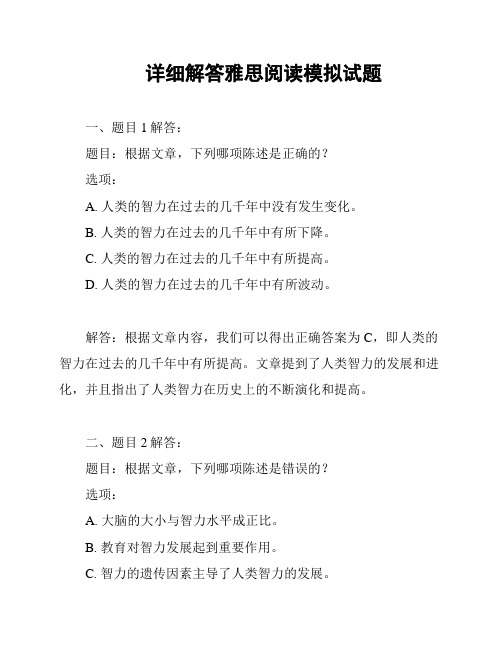
详细解答雅思阅读模拟试题一、题目1解答:题目:根据文章,下列哪项陈述是正确的?选项:A. 人类的智力在过去的几千年中没有发生变化。
B. 人类的智力在过去的几千年中有所下降。
C. 人类的智力在过去的几千年中有所提高。
D. 人类的智力在过去的几千年中有所波动。
解答:根据文章内容,我们可以得出正确答案为C,即人类的智力在过去的几千年中有所提高。
文章提到了人类智力的发展和进化,并且指出了人类智力在历史上的不断演化和提高。
二、题目2解答:题目:根据文章,下列哪项陈述是错误的?选项:A. 大脑的大小与智力水平成正比。
B. 教育对智力发展起到重要作用。
C. 智力的遗传因素主导了人类智力的发展。
D. 社会环境对智力发展有一定影响。
解答:根据文章内容,我们可以得出错误答案为A,即大脑的大小与智力水平成正比。
文章提到了大脑的大小与智力水平之间并没有直接的正比关系,而是有很多其他复杂的因素影响智力的发展。
三、题目3解答:题目:根据文章,下列哪项陈述是正确的?选项:A. 遗传因素是唯一影响智力的因素。
B. 教育对智力的发展没有任何作用。
C. 大脑的发育与智力水平无关。
D. 社会环境对智力的发展有重要影响。
解答:根据文章内容,我们可以得出正确答案为D,即社会环境对智力的发展有重要影响。
文章提到了智力发展受到遗传因素和社会环境的共同影响,社会环境对智力的发展起到了重要作用。
四、题目4解答:题目:根据文章,下列哪项陈述是错误的?选项:A. 人类的智力在过去的几百年中发生了显著变化。
B. 大脑的发育和智力的发展是相关的。
C. 教育对智力的发展起到了关键作用。
D. 遗传因素对智力的发展有一定影响。
解答:根据文章内容,我们可以得出错误答案为A,即人类的智力在过去的几百年中发生了显著变化。
文章提到了人类智力的发展和进化是一个长期的过程,并没有明确提及过去几百年中智力的变化。
五、题目5解答:题目:根据文章,下列哪项陈述是正确的?选项:A. 大脑大小是决定智力水平的唯一因素。
雅思4真题答案大全及解析
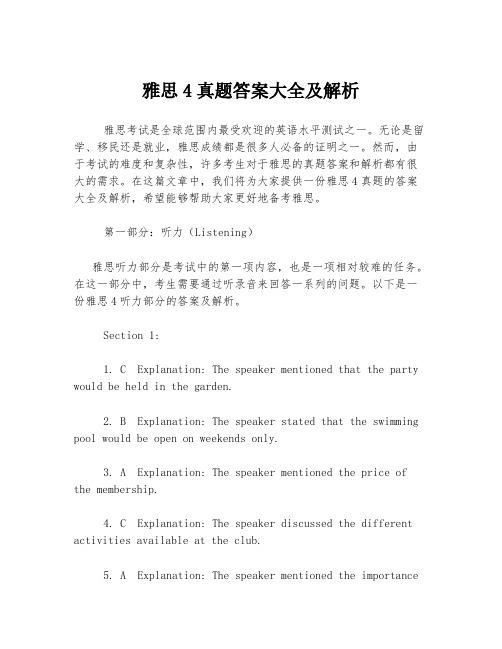
雅思4真题答案大全及解析雅思考试是全球范围内最受欢迎的英语水平测试之一。
无论是留学、移民还是就业,雅思成绩都是很多人必备的证明之一。
然而,由于考试的难度和复杂性,许多考生对于雅思的真题答案和解析都有很大的需求。
在这篇文章中,我们将为大家提供一份雅思4真题的答案大全及解析,希望能够帮助大家更好地备考雅思。
第一部分:听力(Listening)雅思听力部分是考试中的第一项内容,也是一项相对较难的任务。
在这一部分中,考生需要通过听录音来回答一系列的问题。
以下是一份雅思4听力部分的答案及解析。
Section 1:1. C Explanation: The speaker mentioned that the party would be held in the garden.2. B Explanation: The speaker stated that the swimming pool would be open on weekends only.3. A Explanation: The speaker mentioned the price of the membership.4. C Explanation: The speaker discussed the different activities available at the club.5. A Explanation: The speaker mentioned the importanceof booking in advance.Section 2:6. B Explanation: The speaker talked about the new art exhibition at the museum.7. A Explanation: The speaker mentioned the time and location of an upcoming lecture.8. C Explanation: The speaker stated that theexhibition would run for a month.9. A Explanation: The speaker discussed the discounts available for senior citizens.10. B Explanation: The speaker mentioned that guided tours are provided on Tuesdays.Section 3:11. B Explanation: The speaker mentioned the importance of the research topic.12. A Explanation: The speaker discussed thedifficulties they faced during the research.13. C Explanation: The speaker talked about the method they used for data collection.14. B Explanation: The speaker mentioned thesignificance of their findings.15. A Explanation: The speaker stated the implications of the research.Section 4:16. C Explanation: The speaker discussed the characteristics of different types of plants.17. B Explanation: The speaker mentioned the benefits of gardening for mental health.18. A Explanation: The speaker stated that gardening isa popular hobby in the country.19. C Explanation: The speaker discussed the importance of soil quality for plant growth.20. B Explanation: The speaker mentioned the upcoming gardening workshop.以上是雅思4听力部分的答案及解析。
雅思阅读考试模拟测试题带答案

雅思阅读考试模拟测试题带答案2015年雅思阅读考试模拟测试题带答案It is estimated that around of the approximately six thousand languages that are spoken today, over three thousand of them are likely to have disappeared by the year 2100. Many of these are now classified as endangered languages and are classified as such by factors such as the number of speakers a language has, the age of the speakers, and the percentage of the youngest generation acquiring fluency in the language. For example, a language with many tens of thousands of speakers may be considered endangered if the children in the community are no longer learning the language. This scenario may happen in a place like Indonesia which as many different languages in use, but is trying to make communication easier by teaching a national language nation-wide. In another scenario, a language may only have a few hundred speakers but may not be considered endangered because all of the children in the community are learning the language.Once a language is classified as endangered, conservation efforts may be made in an attempt to save or revive the language. Whether or not to make such efforts is a decision which is ultimately made by the speakers of the language themselves, but success often requires a great deal of help and approval from the government or other authorities.One of the most famous language conservation success stories is that of the Welsh language. Historically, large numbers of Welsh people spoke only Welsh, but eventually English became the main language of Wales and fewer and fewer people learned Welsh. Conservation efforts began to be made in themid-20th century with the establishment of such organisations as the Welsh Language Association in 1962. The Welsh Language Act and the Government of Wales Act, both passed in the 1990s, protected the Welsh language and made sure that English and Welsh would have equal status in Wales. Since 2000, the study of the Welsh language has been a compulsory subject in school. Today, over 22% of the population of Wales are Welsh speakers, up from 18% in 1991.Another famous example, Hebrew, is not so much a story of language conservation as much as language revitalisation. Hebrew was once a spoken language but by the 4th century BCE it had been replaced by Aramaic. Hebrew continued to be used for religious purposes and in literature but the language was no longer used for everyday purposes. In the 19th century, there was a movement to revive Hebrew as a spoken language, and when the State of Israel was founded in 1948, Hebrew was adopted as the official language. There was some resistance to this idea, as Hebrew was considered a religious language, not a language to be used for common communication. In addition, because Hebrew was an ancient language, it lacked many of the words that are used in modern times and many new words had to be coined. However, because there was a need for a common language in Israel, the language was accepted and now thrives.The successes of language conservation are many, but many more attempts at language preservation do not succeed and there are many languages that have not survived except for a few recordings made by the last native speakers before their deaths. In some cases, the number of remaining speakers at the start of conservation efforts was not enough to sustain revitalisation, and in others, efforts may fail because there is often no economicbenefit to learning an endangered language at the expense of a more commonly spoken national or international language.QuestionsDo the following statements agree with the information given in the article?In boxes 1-10 on your answer sheet writeTRUE if the statement agrees with the informationFALSE if the statement contradicts the informationNOT GIVEN if there is no information on this1) Half of the languages spoken today will be gone by 2100.2) A language may be considered endangered if children of the speakers are no longer learning the language.3) Indonesian is an endangered language.4) Most endangered languages today are saved and revived.5) Welsh was revived mainly due to government legislature.6) The number of Welsh speakers is expected to rise rapidly in the future.7) All school lessons in Wales are taught in Welsh.8) Hebrew died out completely in the 4th century BCE.9) Hebrew and Aramaic are similar languages.10) Many new terms had to be added to Hebrew to make it functional for today’s world.Answers1) F2) T3) NG4) F5) T6) NG7) NG8) F9) NG10) T【2015年雅思阅读考试模拟测试题带答案】。
阅读及答案4雅思阅读真题及答案
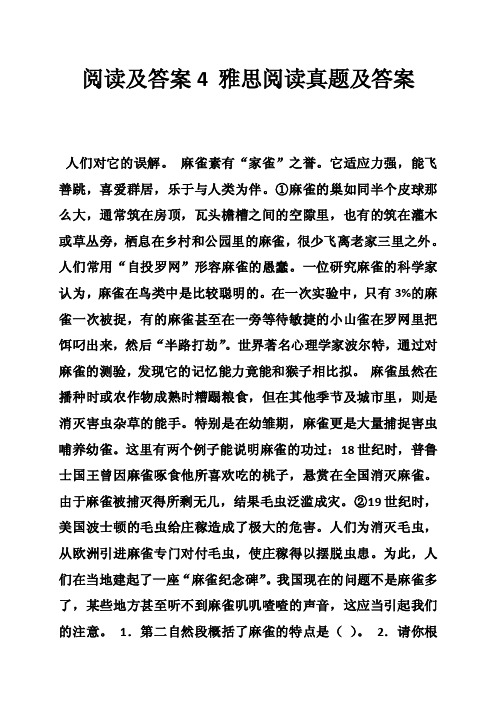
阅读及答案4 雅思阅读真题及答案人们对它的误解。
麻雀素有“家雀”之誉。
它适应力强,能飞善跳,喜爱群居,乐于与人类为伴。
①麻雀的巢如同半个皮球那么大,通常筑在房顶,瓦头檐槽之间的空隙里,也有的筑在灌木或草丛旁,栖息在乡村和公园里的麻雀,很少飞离老家三里之外。
人们常用“自投罗网”形容麻雀的愚蠢。
一位研究麻雀的科学家认为,麻雀在鸟类中是比较聪明的。
在一次实验中,只有3%的麻雀一次被捉,有的麻雀甚至在一旁等待敏捷的小山雀在罗网里把饵叼出来,然后“半路打劫”。
世界著名心理学家波尔特,通过对麻雀的测验,发现它的记忆能力竟能和猴子相比拟。
麻雀虽然在播种时或农作物成熟时糟蹋粮食,但在其他季节及城市里,则是消灭害虫杂草的能手。
特别是在幼雏期,麻雀更是大量捕捉害虫哺养幼雀。
这里有两个例子能说明麻雀的功过:18世纪时,普鲁士国王曾因麻雀啄食他所喜欢吃的桃子,悬赏在全国消灭麻雀。
由于麻雀被捕灭得所剩无几,结果毛虫泛滥成灾。
②19世纪时,美国波士顿的毛虫给庄稼造成了极大的危害。
人们为消灭毛虫,从欧洲引进麻雀专门对付毛虫,使庄稼得以摆脱虫患。
为此,人们在当地建起了一座“麻雀纪念碑”。
我国现在的问题不是麻雀多了,某些地方甚至听不到麻雀叽叽喳喳的声音,这应当引起我们的注意。
1.第二自然段概括了麻雀的特点是()。
2.请你根据文中信息进行判断(对的画√,错的画ⅹ)(1)在一次实验中,有97%的麻雀不会二次被捉。
()(2)麻雀其实是一种愚蠢的鸟。
()(3)麻雀素有“家雀”之誉,它们很少飞离老家两三里之外。
()3.科学家认为麻雀是“比较聪明的”,这种说法的根据是4.请写出画线部分运用了何种说明方法。
①②(二)人的一生中,总会出现困境。
每当陷入困境时,我就会不由自主地想起那次迷路。
那是暑假期间,我与好友李强到一处森林旅游,因贪恋景色,不知不觉走进了森林腹地。
迷路时,天色已晚。
我们在山脊上走,开始路还相当宽阔,后来越走越窄。
根据经验估计,我们左右都是无底的深渊。
雅思考试模拟试题及答案解析(4)
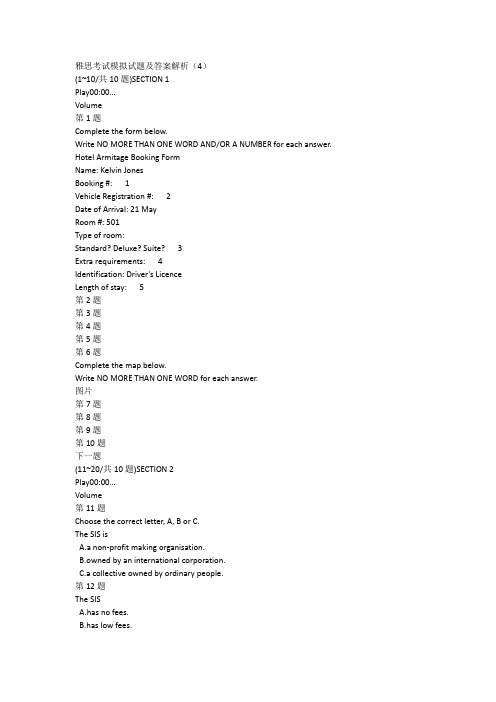
●6 is responsible for less food and higher prices
Term Deposit
—safe and
8 , low risk$1,000Calculated daily and paid
monthly, quarterly, or
at maturityOnly at maturity
9
—longer term but
better returns$5,00OCalculated daily and
but better to limit to
once a month
6NoneOne interest rate, calculated
daily and paid on 7Anytime—no penalty
for withdrawals
INVESTMENT OPTIONS
Investment AccountMinimum depositInterest InformationAccess
telephone. No account
or 4 fees
Stairs SaverNone—but higher
rates for bigger
balances3 tiers plus 5 .
Calculated daily and paid
monthlyUnlimited withdrawals
雅思阅读模拟试题和答案

雅思阅读模拟试题和答案在雅思考试中,阅读模块是考生们最为重视和关注的部分之一。
通过阅读模拟试题并了解正确答案,考生们可以更好地熟悉考试内容和技巧,提高阅读理解能力,从而取得更好的成绩。
以下是一篇关于雅思阅读模拟试题和答案的文章。
试题一:阅读下面的短文,回答问题。
The Industrial Revolution, which took place from the late 18th century to the early 19th century, greatly transformed the world, bringing about new technologies and significant changes in the economic and social structures of many countries. One of the key developments during this period was the mechanization of textile production.Prior to the Industrial Revolution, textile production was a labor-intensive process, with spinning and weaving done by hand. However, with the invention of the spinning jenny and the power loom, the production process became much more efficient and less time-consuming. This led to the establishment of textile factories and the mass production of cloth, which in turn fueled the growth of industrialization.The spinning jenny, invented by James Hargreaves in 1764, allowed a single worker to simultaneously spin multiple spools of thread. This greatly increased the productivity of the spinning process. Similarly, the power loom, invented by Edmund Cartwright in 1785, automated the process ofweaving, reducing the need for skilled labor and further increasing production capacity.The mechanization of textile production had profound effects on various aspects of society. Firstly, it significantly lowered the cost of textiles, making them more affordable and accessible to a larger population. This led to an increase in the standard of living for many people, as they were able to dress themselves, their families, and their homes with quality fabrics at a lower cost. Secondly, it created a demand for raw materials such as cotton, which in turn drove the expansion of colonial territories. Finally, it also resulted in the growth of urban areas, as textile factories were built in cities to take advantage of the power supply and transportation networks.Question 1: What was one of the key developments during the Industrial Revolution?Question 2: Who invented the spinning jenny?Question 3: How did the mechanization of textile production affect society?答案一:Question 1: The mechanization of textile production.Question 2: James Hargreaves.Question 3: It lowered the cost of textiles, increased the standard of living, stimulated the demand for raw materials, and contributed to urban growth.试题二:阅读下面的短文,选择正确的答案。
- 1、下载文档前请自行甄别文档内容的完整性,平台不提供额外的编辑、内容补充、找答案等附加服务。
- 2、"仅部分预览"的文档,不可在线预览部分如存在完整性等问题,可反馈申请退款(可完整预览的文档不适用该条件!)。
- 3、如文档侵犯您的权益,请联系客服反馈,我们会尽快为您处理(人工客服工作时间:9:00-18:30)。
雅思阅读模拟试题及答案解析(4)Selling Digital Music without Copy-protection Makes SenseA. It was uncharacteristically low-key for the industry’s greatest showman. But the essay published this week by Steve Jobs, the boss of Apple,on his firm’s website under the unassuming title “Thoughts on Music” has nonetheless provoked a vigorous debate about the future of digital music,which Apple dominates with its iPod music-player and iTunes music-store. At issue is “digital rights management” (DRM)—the technology guarding downloaded music against theft. Since there is no common standard for DRM, it also has the side-effect that songs purchased for one type of music-player may not work on another. Apple’s DRM system, called FairPlay, is the most widespread. So it came as a surprise when Mr. Jobs called for DRM for digital music to be abolished.B. This is a change of tack for Apple. It has come under fire from European regulators who claim that its refusal to license FairPlay to other firms has “locked in” customers. Since music from the iTunes store cannot be played on non-iPod music-players (at least not without a lot of fiddling),any iTunes buyer will be deterred from switching to a device made by a rival firm, such as Sony or Microsoft. When French lawmakers drafted a bill last year compelling Apple to open up FairPlay to rivals, the company warned of “state-sponsored piracy”. Only DRM, it implied, could keep the pirates at bay.C. This week Mr. Jobs gave another explanation for his former defence of DRM: the record companies made him do it. They would make their music available to the iTunes store only if Apple agreed to protect it using DRM. They can still withdraw their catalogues if the DRM system is compromised. Apple cannot license FairPlay to others, says Mr Jobs, because it would depend on them to produce security fixes promptly. All DRM does is restrict consumer choice and provide a barrier to entry, says Mr Jobs; without it there would be far more stores and players, and far more innovation. So, he suggests, why not do away with DRM and sell music unprotected?“This isclearly the best alternative for consumers,” he declares,“and Apple would embrace it in a heartbeat.”D. Why the sudden change of heart? Mr Jobs seems chiefly concerned with getting Europe’s regulators off his back. Rather than complaining to Apple about its use of DRM, he suggests,“those unhappy with the current situation should redirect their energies towards persuading the music companies to sell their music DRM-free.” Two and a half of the four big record companies, he helpfully points out, are European-owned. Mr Jobs also hopes to paint himself as a consumer champion. Apple resents accusations that it has become the Microsoft of digital music.E. Apple can afford to embrace open competition in music players and online stores. Consumers would gravitate to the best player and the best store, and at the moment that still means Apple’s. Mr Jobs is evidently unfazed by rivals to the iPod. Since only 3% of the music in a typical iTunes library is protected, most of it can already be used on other players today,he notes. (And even the protected tracks can be burned onto a CD and then re-ripped.) So Apple’s dominance evidently depends far more on branding and ease of use than DRM-related “lock in”.F. The music giants are trying DRM-free downloads. Lots of smaller labels already sell music that way. Having seen which way the wind is blowing, Mr Jobs now wants to be seen not as DRM’s defender, but as a consumer champion who helped in its downfall. Wouldn’t it lead to a surge in piracy? No, because most music is still sold unprotected on CDs, people wishing to steal music already can do so. Indeed, scrapping DRM would probably increase online-music sales by reducing confusion and incompatibility. With the leading online store, Apple would benefit most. Mr Jobs’s argument, in short, is transparently self-serving. It also happens to be right.Questions 1-7 Do the following statemets reflect the claims of the writer in Reading Passage 1?Write your answer in Boxes 1-7 on your answer sheet.TRUE if the statement reflets the claims of the writerFALSE if the statement contradicts the claims of the writerNOT GIVEN if it is impossbile to say what the writer thinks about this1. Apple enjoys a controlling position in digital music market with its iPod music-player and iTunes music-store.2. DRM is a government decree issued with a purpose to protect downloaded music from theft by consumers.3. Lack of standardization in DRM makes songs bought for one kind of music player may not function on another.4. Apple has been criticized by European regulators since it has refused to grant a license FairPlay to other firms.5. All music can be easily played on non-iPod music devices from Sony or Microsoft without too much fiddling.6. Apple depends far more on DRM rather than branding for its dominance of the digital music devices.7. If DRM was cancelled, Sony would certainly dominate the international digital music market.Questions 8-10 Choose the appropriate letters A-D and write them in boxes 8-10 on your answe sheet.8. Which of the following statements about Mr. Jobs’ idea of DRM is NOT TRUE?A. DRM places restrictions on consumer’ choice of digital music products available.B. DRM comples iTunes buyers to switch to a device made by Sony or Microsoft.C. DRM constitutes a barrier for potential consumers to enter digital music markets.D. DRM hinders development of more stores and players and technical innovation.9. The word “unfazed” in line 3 of paragraph E, means___________.A. refusedB. welcomedC. not botheredD. not well received10. Which of the following statements is TRUE if DRM was scapped?A. Sony would gain the most profit.B. More customers would be “locked in”.C. A sudden increase in piracy would occur.D. Online-music sales would probably decrease.Questions 11-14 Complete the notes below.Choose NO MORE THAN THREE WORDS from Reading Passage 1 for each answer.Write your answers in boxes 11-14 on your answer sheet.Mr. Steve Jobs, the boss of Apple, explains the reason why he used to defend DRM, saying that the company was forced to do so: the record companies would make their music accessible to …11...only if they agreed to protect it using DRM; they can still…12…if the DRM system is compromised. He also provides the reason why Apple did not license FairPlay to others: the company relies on them to …13….But now he changes his mind with a possible expectation that Europe’s regulators would not trouble him any more in the future. He proposes that those who are unsatisfactory with the current situation in digital music market should …14… towards persuade the music companies to sell their music DRM-free.Notes to Reading Passage 11. low-key:抑制的,受约束的,屈服的2. showman:开展览会的人,出风头的人物3. unassuming:谦逊的,不夸耀的,不装腔作势的4. iPod:(苹果公司出产的)音乐播放器5. iTunes store:(苹果公司出产的)在线音乐商店6. get off person's back:不再找某人的麻烦,摆脱某人的纠缠7. gravitate:受吸引,倾向于8. unfazed:不再担忧,不被打扰Keys and explanations to the Questions 1-131. TRUESee the second sentence in Paragraph A “… the future of digital music,which Apple dominates with its iPod music-player and iTunes music-store.”2. FALSESee the third sentence in Paragraph A “…At issue is “digital rights management” (DRM)—the technology guarding downloaded music against theft.”3. TRUESee the fourth sentence in Paragraph A “Since there is no common standard for DRM, it also has the side-effect that songs purchased for one type of music-player may not work on another.”4. TRUESee the second sentence in Paragraph B “It has come under fire from European regulators who claim that its refusal to license FairPlay to other firms has “locked in” customers.”5. NOT GIVENThe third sentence in Paragaph B only mentions music from the iTunes store, nothing about that of Sony or Microsoft. “Since music from the iTunes store cannot be played on non-iPod music-players (at least not without a lot of fiddling).”6. FALSESee the last sentence in Paragraph E “So Apple’s dominance evidently depends far more on branding and ease of use than DRM-related “lock in”.7. NOT GIVENSee the fourth sentence in Paragraph F only mentions music generally, no particular information about business prospect of Sony “Indeed, scrapping DRM would probably increase online-music sales by reducing confusion and incompatibility.”8. BSee the fourth sentence of Paragraph C “All DRM does is restrict consumer choice and provide a barrier to entry, says Mr Jobs; without it there would be far more stores and players, and far more innovation.”9. CSee the third sentence of Paragraph E and the context “Mr Jobs is evidently unfazed by rivals to the iPod. Since only 3% of the music in a typical iTunes library is protected, most of it can already be used on other players today.”10. ASee the last four sentences of Paragraph F “Wouldn’t it lead to a surge in piracy? No, because most music is still sold unprotected on CDs, people wishing to steal music already can do so. Indeed, scrapping DRM would probably increase online-music sales by reducing confusion and incompatibility. With the leading online store, Apple would benefit most.”11. the iTunes storeSee the second sentence of Paragraph C “They would make their music available to the iTunes store only if Apple agreed to protect it using DRM.”12. withdraw their cataloguesSee the third sentence of Paragraph C “They can still withdraw their catalogues if the DRM system is compromised.”13. produce security fixesSee the fourth sentence of Paragraph C “Apple cannot license FairPlay to others, says Mr Jobs, because it would depend on them to produce security fixes promptly.”14. redirect their energiesSee the second sentence of Paragraph D “Rather than complaining to Apple about its use of DRM, he suggests,“those unhappy with the current situation should redirect their energies towards persuading the music companies to sell their music DRM-free.”。
